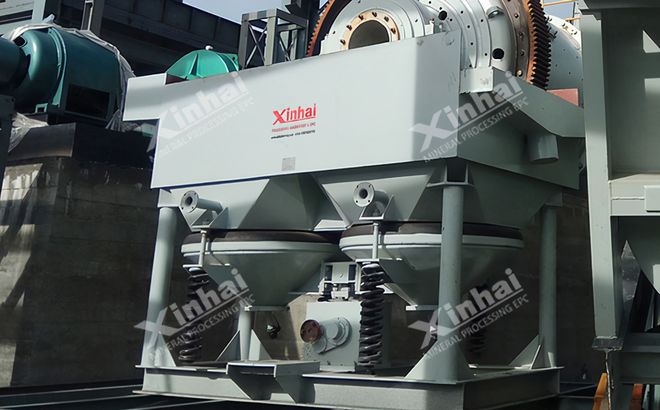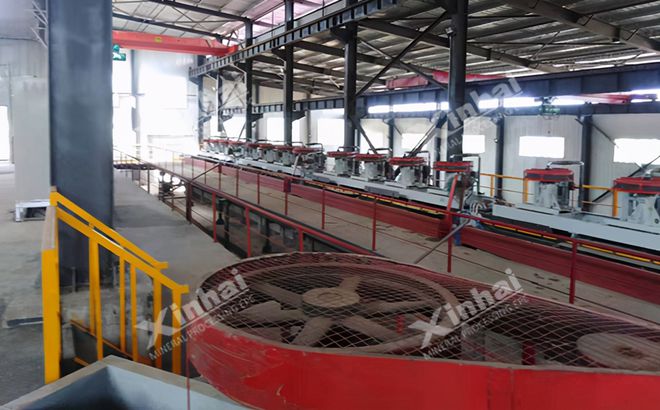Siderite is difficult to separate because of its low density, weak magnetism, fine embedded particle size and low grade. At present, there are four common beneficiation methods for siderite, namely gravity separation, flotation, high intensity magnetic separation and roasting low intensity magnetic separation. Magnetic separation after roasting is a typical process method, but in recent years, the strong magnetic separation method has a good development momentum. This article introduces four commonly used siderite beneficiation methods and the strong magnetic separation process flow.

Gravity concentration is one of the traditional beneficiation processes to enrich single siderite, which is applicable to the beneficiation of coarse and medium grained disseminated siderite. Heavy medium beneficiation and jigging beneficiation are two common methods.
Concentrate siderite with heavy medium: use the fine particles of solid (such as ferrosilicon, magnetite, galena) with high density and easy to regenerate and water to mix into a heavy suspension with adjustable density as the separation medium. The ore particles with density greater than the medium density sink, and the floaters on the ore particles with density less than the medium density can be separated. This method has large production capacity, low investment, high specific gravity separation accuracy, strong adaptability to the particle size of ore dressing stone, and is suitable for large-scale production. The common heavy medium concentrators for siderite include heavy medium vibrating trough, heavy medium cyclone and heavy medium vortex.
Siderite separation by jigging: the process of separating the mineral particle mixture according to the density difference between ores, putting it into the vertically ascending and descending variable speed medium flow, and then separating it. The jig has the characteristics of simple structure, low investment, high separation efficiency, high recovery rate, low operating cost, etc. It can remove about 80% of the waste rock in siderite under suitable conditions.
Although the ore grade is low and the mineral composition is complex, with the development of high intensity magnetic separation technology and the improvement of equipment level, the use of high intensity magnetic separation technology can successfully separate hematite, specularite, limonite and other weak magnetic iron minerals including (magnesium) siderite, and has obtained encouraging achievements.
The equipment mainly used in the high intensity magnetic separation process of siderite is a wet high intensity magnetic separator. After the weak magnetic separation, the siderite is discarded with a wet high intensity magnetic separator, and the iron grade and iron recovery are improved.

From the origin of siderite resources, because there are few independent siderite resources and the iron content of siderite itself is low, the flotation separation of weakly magnetic iron minerals in industry mostly refers to hematite, limonite, specularite and other iron minerals including siderite. The flotation of weakly magnetic minerals such as siderite mainly includes two flotation processes: positive flotation for iron enrichment and reverse flotation for desilication.
At present, the flotation of siderite in industrial production is mainly the mixed iron mineral resources containing siderite. The overall process aims at the separation of weakly magnetic iron minerals, such as the flotation process of Wangjiatan Iron Mine of Kunming Iron and Steel Co., Ltd. and Ekou Iron Mine of Taiyuan Iron and Steel Co., Ltd. For the mineral system containing barite, specularite, siderite and quartz from Jingtieshan Mine of Jiuquan Iron and Steel Co., Ltd., by adjusting the pH value of the slurry and using sulfonate as the collector, the preferential flotation of barite and specularite can be carried out, and most of the siderite can also be recovered together with specularite.
Siderite is a carbonate of iron. After roasting in a neutral or weak reducing atmosphere, the carbon dioxide in the ore is decomposed, which improves the ore grade. The magnetism of iron minerals is significantly enhanced, while that of gangue minerals does not change much. High efficiency weak magnetic separation method can be used for material separation.
Common magnetization roasting methods can be divided into reduction roasting, neutral roasting and oxidation roasting, among which reduction roasting is the common method for siderite beneficiation. The reduction roasting devices commonly used are shaft furnace (75~15 mm) and rotary kiln (15~0 mm). The roasting temperature is generally controlled at 650~900 ℃; The roasting time is 6-8 h for a long time and 15-10 min for a short time. Through this beneficiation process, siderite can be transformed into magnetite, and then separated by a weak magnetic separator to obtain a high grade concentrate.

The main equipment of the high intensity magnetic separation method is the high intensity magnetic separator. Because the high intensity magnetic separator has a large processing capacity and the materials are mostly separation tailings, it is suitable for the pretreatment of iron resource recovery. In recent years, SLon high gradient high intensity magnetic separator, which has a pulsating effect on the pulp, has been successfully applied in industry, effectively improving the separation index of weakly magnetic iron oxide minerals including siderite. The process flow of high intensity magnetic separation is as follows:
Put the siderite ore to be selected into the crusher for primary crushing to obtain particles and powders<10mm.
Put the particles and powders into the screening machine with strong magnetic field for screening to obtain magnetic siderite particles and powders, and discard the particles and powders that fail to pass the screening.
Put qualified particles and powders into the ball mill for wet ball milling to obtain pulp.
The slurry is sent to the spiral screening machine for screening, and the particles>100um are ball milled again.
Put siderite ore<100um into the mud box and then into the mud tank for desliming treatment, and repeatedly enter the mud box and mud tank for several times to get the siderite ore after desliming.
The siderite ore after desliming is sent to the wet high intensity magnetic separator for cleaning. The wet high intensity magnetic separator outputs high grade magnetic concentrate powder, low-grade magnetic tailings powder and medium grade magnetic middling ore powder in three ways respectively.
The concentrate powder is warehoused, and the middling particles and tailings are transported to the tailing yard.
The above are the four common methods of siderite beneficiation and the introduction of the process flow of high intensity magnetic separation. Here we remind you that the determination of the process method should follow a scientific and rigorous attitude and be based on the results of the beneficiation test, so as to obtain a better beneficiation effect.